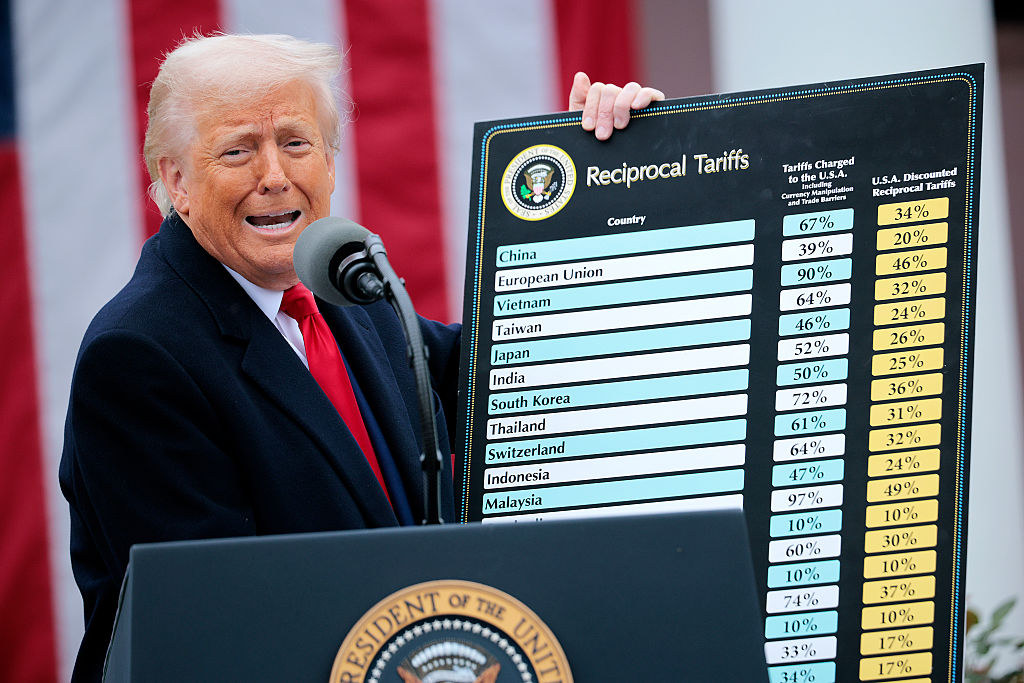What Tariffs Mean for Your Sector Exposure
New, higher and changing tariffs will ripple through the economy and into share prices for many quarters to come.


About four months after Liberation Day and a little more than two-thirds of the way into second-quarter reporting season, we're still learning about President Donald Trump's tariffs and the effects they'll have on revenue and earnings for specific sectors and stocks.
Some situations are more obvious than others. But conference call commentary from C-suite executives generally suggests management teams are still seeking clarity about the impact of Trump's tariffs on revenue and margins – and will be for some time.
Efforts to offset potential negative impacts generally include controlling costs and managing prices. Commentary so far indicates supply chain adjustments and other cost-cutting moves are already happening, with scaled-back promotions and straight-up price hikes on the horizon.
From just $107.88 $24.99 for Kiplinger Personal Finance
Become a smarter, better informed investor. Subscribe from just $107.88 $24.99, plus get up to 4 Special Issues

Sign up for Kiplinger’s Free Newsletters
Profit and prosper with the best of expert advice on investing, taxes, retirement, personal finance and more - straight to your e-mail.
Profit and prosper with the best of expert advice - straight to your e-mail.
We have heard multiple explicit profit warnings from companies operating in different goods-producing and consumer-facing spaces, such as automakers. However, some companies are revising their forecasts for the impact of Trump's tariffs, even providing more optimistic guidance.
The bottom line is impacts will vary from sector to sector and stock to stock, and we'll be tracking them now, for the next several quarters and the next several years as the Trump administration attempts to reshape global trade.
Headwinds or tailwinds
Since April 2, when President Trump first introduced his tariffs, we've seen a steep stock market sell-off followed by a historic rally to new all-time highs.
Markets have been similarly moved by incoming inflation data, which will continue to be noisy from report to report and period to period as the impact of tariffs works its way through the economy.
That the S&P 500 and the Nasdaq Composite have made new all-time closing highs and the Dow Jones Industrial Average has come within points of its own fresh peak this summer suggests that market participants are more optimistic now than they were when the indexes bottomed on April 7.
And it's possible, according to WisdomTree macro strategist Samuel Rines, that some impacts of Trump's tariffs could be positive for specific companies and their stock prices, at least in the short term.
"Many of the companies that provided guidance for tariff impacts in the past," Rines wrote in a late-July assessment of second-quarter earnings season, "are guiding away some of the impact in the future."
And we'll continue to hear from companies "with 'too much tariff' priced in," according to Rines, during the current reporting period and for as long as the Trump administration uses tariffs to advance trade and other policy goals.
Expectations management
Second-quarter earnings-per-share growth for the S&P 500 is tracking at 9% year over year as of this writing vs a pre-season estimate of 4%. And more than six of every 10 S&P 500 companies are beating earnings expectations, one of the best performances in a quarter century.
According to FactSet Senior Earnings Analyst John Butters, "Both the percentage of S&P 500 companies reporting positive earnings surprises and the magnitude of earnings surprises are above their 10-year averages."
At the same time, as Goldman Sachs Chief U.S. Equity Analyst David Kostin observes, "Sharp downward revisions to analyst estimates earlier this year created an unrealistically low bar for companies heading into the reporting season, boosting the frequency of earnings beats."
It is a market of stocks, and those stocks represent companies, some with more and some with less exposure to tariffs. Trends with even greater gravity, such as artificial intelligence (AI) and the infrastructure build-out to support it, are also in play.
So the stories to watch over the next several quarters, according to WisdomTree's Rines, are on the ground.
"Some will execute," Rines concludes. "Some will not."
For some groups, it's the theme, for others just a theme. So let's take a look at how your exposure to specific sectors and stocks could be impacted by President Trump's tariffs.

Communication services
Communication services stocks such as Alphabet (GOOGL), Meta Platforms (META) and Netflix (NFLX) that see greater shares of revenue from advertising and subscriptions are likely to be more resilient in a rising-tariffs environment.
GOOGL is up 29%, META 45.4%, and NFLX 33.5% since April 7.
Through August 1, the Communications Services Select SPDR ETF (XLC) is up 21.8% from the April 7 post-Liberation Day bottom.
The sector includes old-school telecoms such as AT&T (T) and Verizon Communications (VZ), which are up 5.6% and 3.9%.
Consumer discretionary
Ford Motor (F), like fellow automakers General Motors (GM), Stellantis (STLA) and Tesla (TSLA), is a consumer discretionary stock.
Ford recently reported its first quarterly loss in two years due to an $800 million tariff hit. F stock is actually up 20.2% since April 7.
GM, which reported $1.1 billion in tariff costs for the second quarter and expects a total impact of $4 billion to $5 billion for the full year, has added 21.6%.
Stellantis expects a $1.5 billion profit hit this year; the stock is up 3.1%.
Tesla's better positioned than traditional automakers in the U.S. market due to its domestic production and supply chain concentration in North America, and this is reflected in its 29.7% gain off the April low.
Meanwhile, Amazon.com (AMZN), up 22.5% since April 7, presents a complex case because of the depth and breadth of its third-party seller market. That's a big question for this and future reporting periods.
All told, the Consumer Discretionary Select SPDR ETF (XLY) is up 19.9% since April 7.
Consumer staples
When Procter & Gamble (PG) reported its second-quarter results, management said it expects approximately $800 million in higher costs for the full year due to Trump's tariffs.
In April, during the depths of post-Liberation Day despair, P&G forecast a full-year hit "in the range of $1 billion to $1.5 billion."
PG, among the biggest and best-known consumer staples stocks, hasn't enjoyed much tailwind from its outlook for a smaller tariff impact, though, slipping 3.8% since its July 29 report.
The Consumer Staples Select Sector SPDR Fund (XLP) is up 4.1% since April 7, but is No. 10 among the 11 S&P 500 sectors during that time frame.
Underperformance reflects the simple difficulties confronting businesses with similar internal cost-and-price options as other types of business, but far fewer external megatrend catalysts (AI, for example) to offset those efforts and support margins.
Energy
Like many companies engaged in significant industrial activities, oil and gas exploration and production companies will face higher costs due to a 50% tariff on imported steel and new duties on other inputs for equipment and infrastructure.
Higher steel and aluminum prices will impact energy stocks in multiple industries, including electric, renewable energy and pipeline companies as well as E&Ps such as Chevron (CVX) and Exxon Mobil (XOM).
The Energy Select Sector SPDR Fund (XLE) has added 10.1% since April 7. CVX is up 9.4%, XOM 7.5%.
Financials
JPMorgan Chase (JPM) and other financial stocks will reflect the macroeconomic impact of tariffs, but not so much any specific cost or price pressures.
The Financials Select Sector SPDR Fund (XLF) is up 17% from the April 7 bottom, with JPM stock rising 35.6%.
Health care
Health care involves a lot of pure domestic service, so health care stocks such as UnitedHealth Group (UNH) will continue to move based on traditional fundamental factors and the market's perception of their ability to generate free cash flow for investors.
At the same time, the Health Care Select Sector SPDR Fund (XLV), down 0.6%, is the only one of the 11 S&P 500 sector ETFs with a negative return since April 7, anchored by beleaguered UNH.
And there are nominal health care stocks such as Johnson & Johnson (JNJ), which forecast during its first-quarter conference call $400 million of 2025 tariff impacts but cut that figure to approximately $200 million when it announced second-quarter results.
JNJ stock is up a little more than 12% so far in 2025, but did see a bit of a post-earnings bounce in late July.
Industrials
Not all companies that make and sell big, heavy machinery and other stuff are stalling out under the weight of Trump's tariffs. It's quite the opposite for many industrial stocks.
The Industrials Select Sector SPDR Fund (XLI) is up 27.9% since April 7, good for the No. 2 ranking among the 11 sector ETFs.
Bellwether Caterpillar (CAT) did report lackluster second-quarter results and does expect a $1.3 billion to $1.5 billion tariff hit in 2025. But management also noted the benefits of its exposure to broader trends such as the infrastructure buildout to support the AI revolution.
And 3M (MMM) guided down the full-year per-share impact of tariffs from a range of 20 cents to 40 cents to a net total impact of 10 cents. As Rines says, that "might sound trivial. But the interaction of expecting a larger impact and preparing for it led 3M to guide earnings higher than its pre-tariff (January) expectation."
Not all companies will manage tariffs the way 3M has, but those that offered worst-case guidance should enjoy the direction of travel.
Information technology
The Magnificent 7 are not all strictly tech stocks. Officially, we see TSLA and AMZN with consumer discretionary stocks, NFLX among communication services.
But we do have Apple (AAPL).
CEO Tim Cook said the iPhone maker faces $1.1 billion in additional costs due to tariffs during the current quarter, up from $800 million for its fiscal 2025 third quarter. But that was lower than management's original $900 million estimate.
Apple's exposure to higher tariffs on goods from China is well-known. AAPL stock is up 11.7% since the April 7 post-Liberation Day bottom. The SPDR S&P 500 ETF (SPY) is up 23.6%.
Microsoft (MSFT), meanwhile, must manage costs and inventories but continues to benefit from strong AI-driven revenue growth in its Azure cloud platform.
Indeed, MSFT stock is up 46.7% since April 7 and recently became the second company ever to surpass the $4 trillion market-cap threshold.
The first $4 trillion stock was, of course, Nvidia (NVDA), which is at the center of the AI revolution and is the hub around which "hyperscalers" are spending billions for an infrastructure build-out that continues to show it's a bigger market force than tariffs.
CEO Jensen Huang has courted President Trump publicly and privately, emphasizing the importance of American leadership of the global AI infrastructure build-out. The White House has also eased restrictions on chip exports to China.
Nvidia will report fiscal 2026 second-quarter results after the closing bell on Wednesday, August 27, and we'll find out more about the durability of the trend.
Already, the other six Mag 7 stocks have grown earnings by 26% year over year vs 4% for the rest of the S&P 500.
The Information Technology Select Sector SPDR Fund (XLK) has led the market back from the April 7 bottom with a gain of 40.4%.
Materials
DuPont (DD) continues to demonstrate its one of the best materials stocks to buy.
Management initially forecast a $60 million profit hit in the second half of 2025 due to tariffs related to shipping products to its own operations in China for final completion.
Management has adjusted its supply chains, sought exemptions and implemented surcharges to offset the impact.
And, now, DuPont expects a tariff-related hit of only $20 million, or 4 cents per share, down from 10 cents per share.
And management raised its full-year guidance to $4.40 per share, as broader business conditions offset tariff concerns.
DD stock is up 21.8% year to date, driving the Materials Select Sector SPDR Fund (XLB), which has risen 15.3% since April 7.
Real estate
The Real Estate Select Sector SPDR Fund (XLRE) has posted a total return of 9.6% since April 7, third-worst among the 11 official sectors.
The U.S. real estate market remains stuck due to high interest rates and other factors contributing to affordability, and real estate stocks continue to struggle.
At the same time, the National Association of Homebuilders notes that "tariffs on building materials and home appliances raise the cost of housing, and consumers end up paying for the tariffs in the form of higher home prices and goods."
According to the NAHB, Canada accounts for approximately 85% of U.S. softwood lumber imports, so the increase in tariff rates on Canada from 25% to 35% will have a significant impact on building costs.
Utilities
Like many industrial operators, utilities could face higher costs for energy storage and other heavy equipment. But management teams are sanguine about their contract protections, their ability to manage their supply chains and their long-term planning. And utility stocks are also enjoying an AI bounce.
Indeed, utilities such as Constellation Energy Group (CEG), Duke Energy (DUK) and NextEra Energy (NEE) are not likely to see material financial impacts to their forecasts or their results due to tariffs.
Electricity demand is rising along with spending on AI infrastructure, with more and more computing capacity requiring more and more power.
The Utilities Select Sector SPDR Fund (XLU) has generated a total return of 19.8% since April 7.
Utilities are actually the top-performing sector on a year-to-date basis with a gain of 17.7% through August 1.
Related content
Profit and prosper with the best of Kiplinger's advice on investing, taxes, retirement, personal finance and much more. Delivered daily. Enter your email in the box and click Sign Me Up.

David Dittman is the former managing editor and chief investment strategist of Utility Forecaster, which was named one of "10 investment newsletters to read besides Buffett's" in 2015. A graduate of the University of California, San Diego, and the Villanova University School of Law, and a former stockbroker, David has been working in financial media for more than 20 years.
-
 My Top 10 Stock Picks for 2026
My Top 10 Stock Picks for 2026Each year, we ask an expert to pick 10 stocks that have the potential to beat the market over the next 12 months. Here are his choices for 2026.
-
 Special Report: The Future of American Politics
Special Report: The Future of American PoliticsThe Kiplinger Letter The Political Trends and Challenges that Will Define the Next Decade
-
 We're Still Bullish on Stocks
We're Still Bullish on StocksWe're still bullish on stocks for 2026, but now is the time for investors to pull in their horns and dial down risk.
-
 My Top 10 Stock Picks for 2026
My Top 10 Stock Picks for 2026Each year, we ask an expert to pick 10 stocks that have the potential to beat the market over the next 12 months. Here are his choices for 2026.
-
 We're Still Bullish on Stocks
We're Still Bullish on StocksWe're still bullish on stocks for 2026, but now is the time for investors to pull in their horns and dial down risk.
-
 These Were the Hottest S&P 500 Stocks of the Year
These Were the Hottest S&P 500 Stocks of the YearAI winners lead the list of the S&P 500's top 25 stocks of 2025, but some of the names might surprise you.
-
 Stocks That Could Take Off in the New Year
Stocks That Could Take Off in the New YearThere are three areas of potential in the 2026 stock market.
-
 Now That You've Built Your Estate Planning Playbook, It's Time to Put It to Work
Now That You've Built Your Estate Planning Playbook, It's Time to Put It to WorkYou need to share details with your family (including passwords and document locations) and stay focused on keeping your plan up to date.
-
 I'm a Wealth Adviser: These 10 Strategies Can Help Women Prepare for Their Impending Financial Power
I'm a Wealth Adviser: These 10 Strategies Can Help Women Prepare for Their Impending Financial PowerAs women gain wealth and influence, being proactive about financial planning is essential to address longevity and close gaps in confidence and caregiving.
-
 I'm a Financial Planning Pro: This Is How You Can Stop These 5 Risks From Wrecking Your Retirement
I'm a Financial Planning Pro: This Is How You Can Stop These 5 Risks From Wrecking Your RetirementYour retirement could be jeopardized if you ignore the risks you'll face later in life. From inflation to market volatility, here's what to prepare for.
-
 Are You Hesitating to Spend Money You've Spent Years Saving? Here's How to Get Over It, From a Financial Adviser
Are You Hesitating to Spend Money You've Spent Years Saving? Here's How to Get Over It, From a Financial AdviserEven when your financial plan says you're ready for a big move, it's normal to hesitate — but haven't you earned the right to trust your plan (and yourself)?